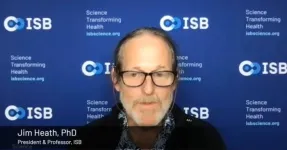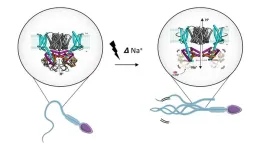(Press-News.org) During the summer of 2022, the Indus River in Pakistan overflowed its banks and swept through the homes of between 30-40 million people. Eight million were permanently displaced, and at least 1,700 people died. Damages to crops, infrastructure, industry, and livelihoods were estimated at $30 billion. In response to this, Stanford researchers from the Natural Capital Project (NatCap) and the Carnegie Institution for Science collaborated on a new way to quickly calculate the approximate depths of flooding in different areas and number of people affected. Their analysis offers insights into potential options and costs for incorporating adaptation to future floods into rebuilding efforts, and shows that climate adaptation measures like these could have helped most, if not all, of the people affected by the flood.
“With events of this scale, it’s very poorly understood what the costs of climate adaptation would be,” said Rafael Schmitt, lead author of the paper, published Oct. 25 in Environmental Research Letters, and a lead scientist with NatCap. He noted that climate adaptation has been a second priority behind climate mitigation – a trend now called the adaptation gap. But clearly, climate change is here now.
“We were motivated by these big floods that are happening now every year, to ask: how can we conduct a very high-level assessment of what it would cost to adapt livelihoods to a changing climate? This could help countries and international donors evaluate the cost-effectiveness of specific adaptation measures,” Schmitt added, noting the default is often to build back to the status quo, resulting in lack of preparedness for future floods, much as rebuilding from Pakistan floods in 2010 did.
A new climate adaptation decision-support tool
The researchers addressed two main options for adapting to future flooding in Pakistan, both of which have been widely implemented across Asia: “moving up” by building elevated structures, or “moving over” by temporarily relocating when floods occur. The depth of flooding – and how far away dry land is – are important factors for determining which response makes sense. Locations with shallow flood depths that are far from dry land would favor elevating buildings, while flood depths of greater than two meters make elevated structures impractical and too costly, based on experiences in nearby Bangladesh. Yet flood stage information (i.e., flood depth or severity) to help make this determination has been hard to come by.
The team brought together satellite data on where flooding occurred, which are readily available in nearly real-time; ground elevation data combined with simplified hydrologic principles (e.g., water flows downhill) to reveal depth; and demographic data on population density, housing, and other infrastructure. This produced their “Floodplain Adaptation Strategies Testbed” or “FAST,” a rapid overview of flood severity and exposure that shows how deep the flooding was in different locations, and how many people were exposed to those depths.
Through FAST, the researchers estimated that 26.6 million people in Pakistan were exposed to low water levels (less than 1 meter), 7.4 million people were exposed to water levels between 1-2 meters, and 5.7 million people were exposed to more than 2 meters of flooding. Based on this and proximity to dry land, there were 27.5 million people in the “move up or over” category (in other words, either strategy could work), 5.1 million people in the “move over” category, 6.3 million people in the “move up” category, and half a million people in the retreat category (where the flood depths were greater than 2 meters and they’re far from dry land). Focusing on the 7.4 million people who experienced 1-2 meters of flood depth, the analysis estimated adaptation costs between $1.5-$3.6 billion, in addition to the $5.8 billion to rebuild housing to the status quo.
Prioritizing equity and resilience in rebuilding efforts
This version of FAST looked only at housing but it could also be applied to other types of infrastructure, such as roads, schools, and hospitals. And in the future, its analyses could become even more detailed because of a new, more advanced, NASA Surface Water and Ocean Topography satellite, or SWOT.
The researchers also recognize that there are other adaptation options besides “moving up or moving over.” For example, local water agencies often rely on dikes, levees, and other “hard” infrastructure – which the researchers warn can promote development in areas prone to flooding, increasing the risk of catastrophic damages if infrastructure fails. Whatever the mix of responses is, FAST could help provide information, but it must be checked to see whether and how these options meet actual community needs.
Without analyses like FAST, reconstruction funding can often be directed to those with the greatest influence, who perhaps need the least support. “The study speaks to the potential to incorporate science-informed adaptation measures into reconstruction and disaster response, helping in investment prioritization. This is particularly useful nowadays with the discussions on mechanisms to compensate countries of the Global South for climate-change-attributed damages,” said Edgar Virgüez, postdoctoral research scientist and deputy group leader at the Carnegie Department of Global Ecology at Stanford and a co-author of the study. The FAST tool could offer a more data-driven and equitable approach to prioritization.
“Countries of the Global South, like my native Colombia, would benefit from process-based model assessments at scale and in a timely manner that can guide the investments of scarce resources. Especially since many of these countries lack timely-generated data, which complicates strategic decision investments,” said Virgüez.
An important outcome of the United Nations Climate Conference last year (COP27) was a new Loss and Damage Fund to provide financial support for countries that are most vulnerable to climate change. In this paper, the team urged funders and governments to rebuild with adaptation in mind. To do that, they say, more science should also be directed toward understanding low-cost adaptation options. “Flood models are data-intensive, and you need specialized knowledge to run them,” said Schmitt. “We need adaptation research that is easier to use and act on. FAST is a step toward that goal.”
END
Stanford collaboration offers new method to analyze implications of large-scale flood adaptation
2023-10-25
ELSE PRESS RELEASES FROM THIS DATE:
Amid cocaine addiction, the brain struggles to evaluate which behaviors will be rewarding
2023-10-25
Rutgers researchers have used neuroimaging to demonstrate that cocaine addiction alters the brain’s system for evaluating how rewarding various outcomes associated with our decisions will feel. This dampens an error signal that guides learning and adaptive behavior.
The observed changes likely propagate a mysterious aspect of some addictive behavior—the tendency to keep doing harmful things that sometimes have no immediate benefit. Those changes also make it harder for long-term users of cocaine to correctly estimate how much benefit they’ll derive from other available actions.
Experts have long hypothesized that cocaine and other addictive ...
Study shows thyroid cancer is more common among transgender female veterans
2023-10-25
A new study by UC Davis Health endocrinology researchers has shown a high prevalence of thyroid cancer among transgender female veterans. It’s the first evidence of such a disparity in the transgender female population in the United States.
The researchers presented their findings this month at the American Thyroid Association Annual Meeting.
The study was prompted by what the doctors noticed while caring for patients.
“As a group of physicians, we observed anecdotally through clinical observation that among 50 transgender women in our clinic, two were diagnosed with thyroid ...
Study suggests marijuana use damages brain immune cells vital to adolescent development
2023-10-25
FOR IMMEDIATE RELEASE
In a mouse study designed to explore the impact of marijuana’s major psychoactive compound, THC, on teenage brains, Johns Hopkins Medicine researchers say they found changes to the structure of microglia, which are specialized brain immune cells, that may worsen a genetic predisposition to schizophrenia. The findings, published Oct. 25 in Nature Communications, add to growing evidence of risk to brain development in adolescents who smoke or eat marijuana products.
“Recreational ...
NASA's Webb makes first detection of heavy element from star merger
2023-10-25
A team of scientists has used multiple space and ground-based telescopes, including NASA’s James Webb Space Telescope, NASA’s Fermi Gamma-ray Space Telescope, and NASA’s Neil Gehrels Swift Observatory, to observe an exceptionally bright gamma-ray burst, GRB 230307A, and identify the neutron star merger that generated an explosion that created the burst. Webb also helped scientists detect the chemical element tellurium in the explosion’s aftermath.
Other elements near tellurium on the periodic table – like iodine, which is needed ...
A bold plan to 3D print artificial coral reef
2023-10-25
Inspired by the remarkable durability of ancient Roman construction materials in seawater, a University of Texas at Arlington civil engineering researcher is attempting to duplicate Roman concrete by developing 3D-printed materials to restore damaged or dying coral reefs.
Warda Ashraf, associate professor in the Department of Civil Engineering, will lead a multidisciplinary team, funded by a $2 million National Science Foundation (NSF) grant, that aims to build 3D-printed artificial reefs. The team’s project is titled “Carbon Sequestration and Coastal Resilience Through 3D Printed Reefs” ...
ESnet turns on 400G circuits to four DOE national labs, supercharging multi-site scientific research
2023-10-25
– By Bonnie Powell
Today’s world-changing scientific research is being conducted by collaborators at far-flung national laboratories who require high-speed, low-latency access to high performance computing facilities and specialized instruments. The Energy Sciences Network (ESnet) is proud to announce that it has supercharged the current and future bandwidth for four of the Department of Energy’s (DOE’s) national laboratories and user facilities, unleashing 400 Gigabit per second (400G) capability for Argonne National Laboratory, ...
MD Anderson Research Highlights for October 25, 2023
2023-10-25
HOUSTON ― The University of Texas MD Anderson Cancer Center’s Research Highlights showcases the latest breakthroughs in cancer care, research and prevention. These advances are made possible through seamless collaboration between MD Anderson’s world-leading clinicians and scientists, bringing discoveries from the lab to the clinic and back.
Recent developments at MD Anderson include positive results from a Phase I trial for patients with TP53-mutant acute myeloid leukemia, a novel machine learning ...
Can AI grasp related concepts after learning only one?
2023-10-25
Humans have the ability to learn a new concept and then immediately use it to understand related uses of that concept—once children know how to “skip,” they understand what it means to “skip twice around the room” or “skip with your hands up.”
But are machines capable of this type of thinking? In the late 1980s, Jerry Fodor and Zenon Pylyshyn, philosophers and cognitive scientists, posited that artificial neural networks—the engines that drive artificial intelligence and machine learning— are not capable of making these connections, known as “compositional generalizations.” However, in the decades ...
Breakthrough T cell discovery has huge potential for engineering custom immune responses
2023-10-25
SEATTLE – T cells are soldiers on the front lines of the human immune system. They are responsible for many important roles, including attacking viral- or bacterial-infected cells and certain cancer cells, and immunological memory – remembering the specific pathogens or the cancer signatures that originally trigger T cells.
Until now, understanding how a T cell forms into a specific role, for example a cell-killing (cytotoxic) T cell or memory T cell, has eluded us. In a paper that will be published online by Cell Reports on October 25, ISB researchers made the breakthrough ...
Sperm's secret voltage switch: Scientists unlock the mystery of motility
2023-10-25
Researchers at Stockholm University have unveiled the hidden intricacies of how sperm go from passive bystanders to dynamic swimmers. This transformation is a pivotal step in the journey to fertilization, and it hinges on the activation of a unique ion transporter.
Imagine sperm as tiny adventurers on a quest to reach the ultimate treasure, the egg. They don't have a map, but they make use of something even more extraordinary: chemo-attractants. These are chemical signals released by the egg that act as siren call, directing and activating the sperm. When these signals bind to receptors on the sperm's surface, it triggers a series of events, starting their movement towards ...




